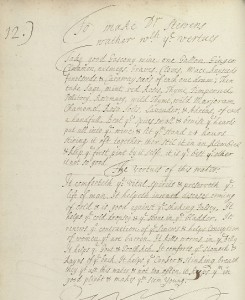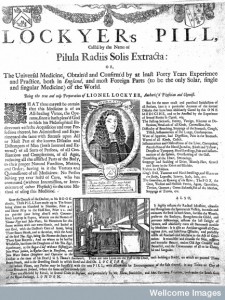By Lisa Smith, W&M Contributor
Perhaps the most famous cure-all of all time is Lydia E. Pinkham’s Vegetable Compound, immortalized in song as “Lily the Pink” (or “The Ballad of Lydia Pinkham”).* Although the original vegetable compound aimed to treat women’s ailments, the song suggests—tongue in cheek–that it might have much wider, rather miraculous applications. The boy with sticky out ears learns how to fly; the man who thought himself Julius Caesar becomes emperor of Rome.
Ridiculous. How, after all, could one drug cure so many ailments? In the modern world, cure-alls just don’t make sense.
But they did at one time. In early modern Europe, cure-all medicines were as likely to be sold by elite physicians as by “quacks” and were often made domestically. These treatments made sense. In a humoral body, with its properties of cold, hot, wet and dry, many seemingly different problems might have the same underlying cause.

Bridget Hyde’s book, late seventeenth century. Wellcome Library, MS 2990, f. 52v. Image Credit: Wellcome Library.
“Dr Stevens’ Water” was a common remedy in English remedy collections kept by well-to-do families. Authors sometimes provided lists of a treatment’s “virtues”, which usefully explain the underlying rationale. Bridget Hyde, for example, described Dr. Stevens’ Water as good for the vital spirits, inward colds, palsy, dropsy, gout, bladder stones, weak sinews, barrenness, worms, tooth-ache, stomach, and “rayns of ye back”. (Reins of the back refers to a urinary or genital discharge.)
An even more impressive and random list than Lydia Pinkham’s Vegetable Compound! What all of these illnesses had in common, however, was that they were caused by cold and wet humours. Looking up each ingredient in herbals and pharmacopoeias reveals that herbs like nutmegs, cloves, mace, aniseeds, lavender and rosemary (for example) had warming and drying properties. Rosemary was ruled by the Sun and Aries; given its warming and comforting properties, it was commonly prescribed for any problems caused by cold humours. Mace, ruled by Venus, was chiefly used for treating problems of the womb.
Sometimes the connections are surprising. “Pertes de sang” (or blood loss) in French collections could refer to general losses of blood, excessive menstruation or uterine bleeding, miscarriage – or diarrhoea. For example, one remedy for fluxes of blood in Mme Lievain’s book (Wellcome Library MS 3258, f. 132) also specified its use in diarrhoea. The main herb, cinquefoil, was commonly used for stomach problems as well as fluxes of all kinds, with a cooling property to sweeten the blood.
Most cure-alls did not try to treat everything, but had a clear rationale and focused on a group of closely-related ailments.
That said, not all cure-alls were created equal — and there were some weird ones out there. Lionel Lockyear, for example, claimed that his pills had the extract of the sun in them. Even better than Lily the Pink, then…
*A rather entertaining song, though it needs an ear worm alert.
Interested in recipes and remedies? This post has been cross-posted at The Recipes Project, a group blog about historical recipes and remedies of all sorts!
Lisa Smith is an Associate Professor of History at the University of Saskatchewan. She writes on gender, family, and health care in England and France (ca. 1600-1800) and recently taught a course on natural and supernatural worlds in early modern Europe. She also blogs weekly on history of medicine and science at her Sloane Letters Blog. For more on multi-purpose remedies, see Smith’s article, “Imagining Women’s Fertility before Technology”, Journal of Medical Humanities, 31, 1 (2010): 69-79.

